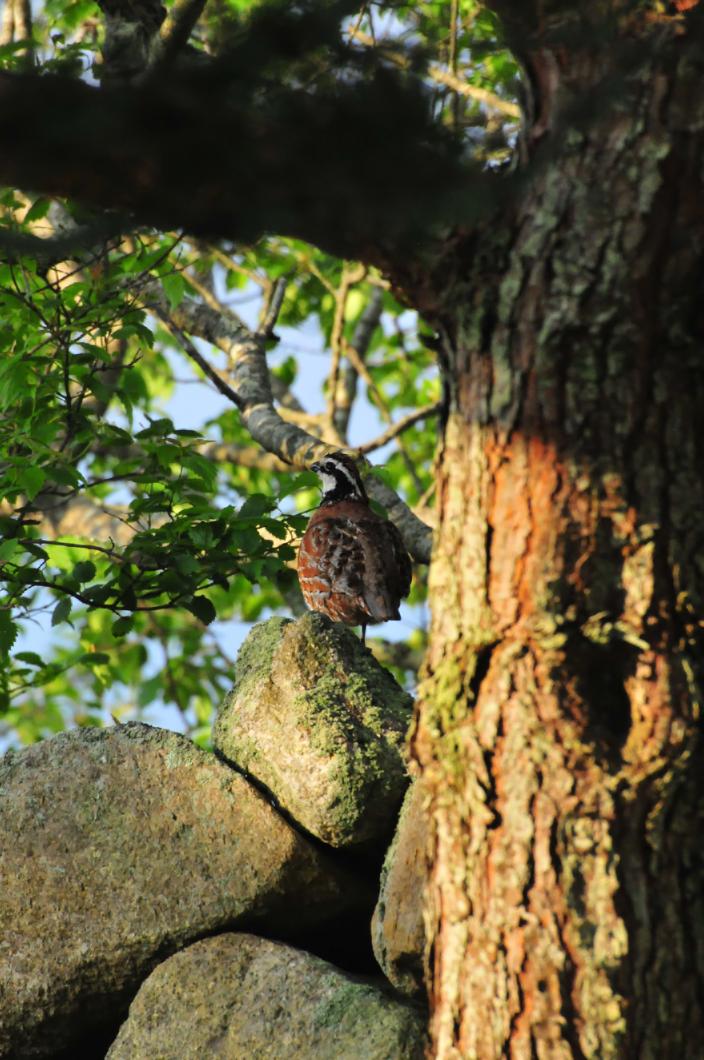It is a challenge to type when you are offshore on a bouncy vessel in a series of line squalls! However, when weather breaks we find we are in good company. Wilson’s storm petrels and an occasional common loon are the most common birds we spot. Pods of dolphins, probably bottle-nosed, play in our bow wake for a while and then veer off to feed or find a new toy. Closer to shore we are joined by laughing, herring and black-backed gulls and common and least terns. A more familiar group of feathered friends are our companions as we near home.
Bird Sightings
Sarah Mayhew in West Tisbury and Tim and Sheila Baird in Edgartown have observed red-bellied woodpeckers feeding on oranges in their yards. The red-bellied woodpecker prefers insects but is actually an omnivore consuming nuts and fruits as well as their favorite arthropods. During nesting season most bird species alter their diets. No doubt these woodpeckers needed a bit more energy from the oranges to cope with their offspring. And speaking of woodpeckers, I heard from an off-Island birder that many of the downy woodpeckers have stained bellies this summer due to the dampness. Seems the wet weather causes the tannins in the wood of the nesting holes of the woodpeckers to act as a dye and stain the woodpeckers’ bellies.
Sarah Mayhew watched young downy woodpeckers checking out the world beyond their nest hole at Sheriff’s Meadow Sanctuary in Edgartown.
I received a comment about my answer to a concerned Vineyarder about the lack of barn swallows around her house since a wind turbine went up. Wind turbines large and small are causing us to do research on their effects. I will do some homework and write a column addressing this subject in the future. I did not intend to make light of the lack of barn swallows or make a connection between wind turbines and birds.
Lanny McDowell sent a series of great photographs of hawk chicks in a Chilmark nest. He was, as was I, unsure of the species. I forwarded the photos to Rob Bierregaard and he answered that the chicks belonged to a Cooper’s hawk, not a red-tailed hawk. Rob mentioned the finer bill and fine streaking on the upper breast and throat as telltale field marks for the Cooper’s hawk youngsters.
Skip Bettencourt sent a photo of a very pale red-tailed hawk that is very similar to the Krider’s form of red-tail that many spotted last summer at Katama.
Blacksmith Valley in Chilmark had some exciting news. Elaine Frost called the hotline to say she had heard not one but two Eastern bobwhites on June 28. Shortly thereafter I received an e-mail that Barbara Lee and David Damroth had also heard the bobwhite and David actually was able to photograph one perched on a stone wall. Barbara Lee also counted four American oystercatchers at Squibnocket on June 28.
Suzie Bowman has seen two northern harriers this week. The first was a nice male hunting the fields at the Panhandle in West Tisbury and the second was a female being harassed by red-winged blackbirds at Felix Neck. Suzie also conducted her first kayak tour of the season on Sengekontgacket and spotted three willets, four American oystercatchers, an irritating number of double-crested cormorants and both common and least terns.
Tom and Barbara Rivers were surprised to hear a whippoorwill call six times at noontime on June 29. That bird’s biological clock was off by eight hours as Tom said it normally calls each evening around 8 to 8:30 p.m
Claudia called to say she had seen several eastern kingbirds at Tradewinds in Oak Bluffs.
Bill Post and Cindy Senning spotted a mystery hawk at Katama on June 27. We are trying to figure it out at present. It is either a Cooper’s hawk or a broad-winged hawk. Stay tuned. Bill also mentioned that there is a green heron at the Edgartown Golf course and also an osprey by the ninth tee.
Please report your bird sightings to the bird hotline at 508-627-4922 or at birds@mvgazette.com.




Comments
Comment policy »